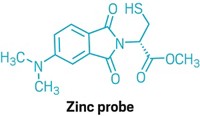Advertisement
Grab your lab coat. Let's get started
Welcome!
Welcome!
Create an account below to get 6 C&EN articles per month, receive newsletters and more - all free.
It seems this is your first time logging in online. Please enter the following information to continue.
As an ACS member you automatically get access to this site. All we need is few more details to create your reading experience.
Not you? Sign in with a different account.
Not you? Sign in with a different account.
ERROR 1
ERROR 1
ERROR 2
ERROR 2
ERROR 2
ERROR 2
ERROR 2
Password and Confirm password must match.
If you have an ACS member number, please enter it here so we can link this account to your membership. (optional)
ERROR 2
ACS values your privacy. By submitting your information, you are gaining access to C&EN and subscribing to our weekly newsletter. We use the information you provide to make your reading experience better, and we will never sell your data to third party members.
Biological Chemistry
Probes track vancomycin-induced cell wall changes
Analogs of cell wall components report switch to drug resistance in real time
by Celia Henry Arnaud
June 19, 2017
| A version of this story appeared in
Volume 95, Issue 25

The antibiotic vancomycin works by interfering with bacterial cell wall synthesis. Some bacteria evade this drug by altering their cell wall precursors so they’re insensitive to it. These adaptations affect the substrates of key enzymes—a dipeptidase that degrades drug-sensitive building blocks and a ligase that stitches together drug-resistant ones. Marcos M. Pires and Sean E. Pidgeon of Lehigh University have now developed a pair of probes for monitoring in live bacteria the changes that lead to vancomycin resistance. Both probes include alkyne handles for attaching fluorescent labels via click chemistry. One probe is a synthetic dipeptide analog of the dipeptidase substrate (Angew. Chem. Int. Ed. 2017, DOI: 10.1002/anie.201704851). Decreasing fluorescence levels of that probe are associated with development of drug resistance. The other probe is an alkyne-containing analog of the





Join the conversation
Contact the reporter
Submit a Letter to the Editor for publication
Engage with us on Twitter